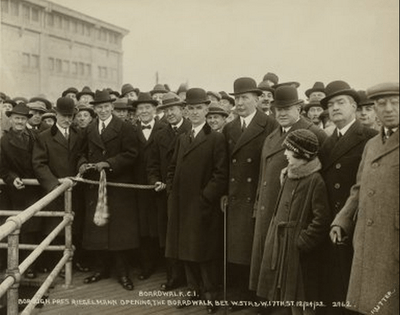Edward J. Riegelmann
Edward J. Riegelmann (September 5, 1869 – January 15, 1941)[1] was an American Democratic politician from Brooklyn, Kings County, New York, best remembered for the Riegelmann Boardwalk.[2]

Biography
Riegelmann was one of five children born to Frederick and Margret Riegelmann on the Lower East Side of Manhattan. The family moved to Williamsburg, Brooklyn ten years later. Riegelemann graduated from the Metropolis Law School, which has since merged with the New York University Law School. He was admitted to the New York State Bar in 1898.[2] He began practicing law with the Charles O. Grim and set out to make a mark in the field of Democratic Politics.
In 1904, Riegelmann was rewarded with leadership of the Democratic State Speakers Bureau in the presidential campaign. He then served as counsel to the Sheriff of Kings County, New York, assistant corporation counsel in Brooklyn, assistant counsel to the New York Public Service Commission, and was Sheriff of Kings County from 1915 to 1917. He was a delegate to Democratic National Convention from New York in 1920. He then ran successfully for Brooklyn Borough President, serving from January 1, 1918[3] to December 31, 1924.[4] During his tenure as borough president, Rieglemann won approval for construction of the Brooklyn Municipal Building at Court and Joralemon Streets, worked to beautify Coney Island and make all access to the beach free, and was largely responsible for the construction of the Coney Island boardwalk, which was eventually named for him. He was a Democratic National Committee alternate in 1924 and 1940, and was appointed Justice of New York Supreme Court 2nd District, by Franklin Roosevelt serving from January 1, 1925 until he retired on December 31, 1939.[5][6]
Edward J. Riegelmann died on January 15, 1941 in Brooklyn, aged 72, and was buried at Calvary Cemetery in Queens.[7]
Riegelmann Boardwalk/Coney Island Beach
One of Riegelmann's most notable projects was the construction of the Riegelmann Boardwalk in Coney Island. As early as the 19th century, it was being developed as a seaside resort, and by the first decade of the 20th century, it had become overcrowded. As Brooklyn Borough President, Riegelmann took charge of beautifying Coney Island and ensuring public access to the beach and shore. After the city secured title to property along the beachfront, the project began in 1921. The boardwalk, which extended between West 37th Street and Ocean Parkway, opened on May 15, 1923.[8]
References
- "Brooklyn's Boardwalk Empire | From the Stacks". New-York Historical Society. May 16, 2018. Retrieved August 13, 2020.
- "Edw. Riegelmann, Ex-Justice, Is Dead – Former Borough President of Brooklyn Served in Supreme Court for 14 Years – Reached Age Limit in '39 – One-Time Kings County Sheriff, Who Began as Messenger, Had Practiced Law Here". The New York Times. January 16, 1941. p. 21. Retrieved July 25, 2016.
- "Greet Brooklyn Officials – Borough President Riegelmann and Others Are Now in Office". The New York Times. January 2, 1918. p. 3. Retrieved July 25, 2016.
- "Guider Now Heads Brooklyn Borough – Democratic Aldermen Unanimously Elect Him to Succeed Justice Riegelmann – Outlines His Policies – New President Calls Schools and Transit Paramount – Will Probably Run in the Fall". The New York Times. January 1, 1925. p. 16. Retrieved July 25, 2016.
- "Riegelmann A Judge Today – Formal Ceremony Attended by Notables to Precede Court's Opening". The New York Times. January 5, 1925. p. 6. Retrieved July 25, 2016.
- The Political Graveyard, Index to Politicians: Ridg to Riggles, retrieved June 5, 2009
- "Riegelmann Rites Held – Colleagues at Funeral of Former Supreme Court Justice". The New York Times. January 18, 1941. p. 15. Retrieved July 25, 2016.
- DESIGNATION REPORT: Coney Island (Riegelmann) Boardwalk
| Political offices | ||
|---|---|---|
| Preceded by Lewis H. Pounds |
Borough president of Brooklyn 1918–1924 |
Succeeded by Joseph A. Guider |
